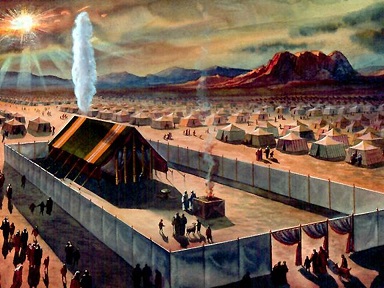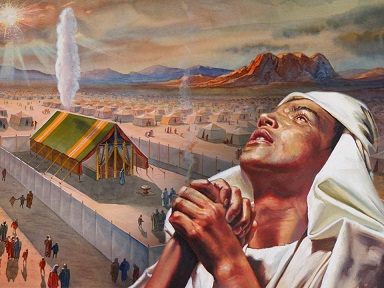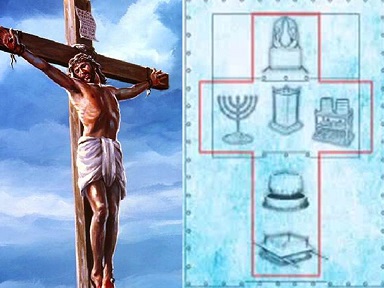LESSON 3
THE SERVICES OF THE SANCTUARY
You are welcome to another edition of Insights from God's Word, a Bible study programme that is committed to sharing God's Word by allowing the Bible to speak for itself.
In this edition, we continue with our series on His Way is in the Sanctuary. The topic for this study is: The Services of the Sanctuary. When God led the Israelites through the wilderness, He commanded Moses to build Him a sanctuary so He will dwell among them (see Exodus 25:8). This sanctuary was to follow a pattern that the Lord showed Moses on the mountain (see Exodus 25:9, 40). The Lord gave specific instructions in regard to the services that were to take place within the sanctuary. Two main services took place within the sanctuary. These services were the daily service and the yearly service. In this study, we will be considering in detail:
i) the daily and yearly services of the sanctuary, and
ii) how these services were perfect pictures of the work of the Redeemer to come.
1) THE DAILY SERVICE
The daily service was a vital part of the religious life of ancient Israel. Each day, the priests ministered at the Holy Place and court of the sanctuary. For instance, every morning and evening, the high priest tended the Golden Lampstand at the Holy Place by trimming its wicks and renewing the oil. The Lampstand was the only source of light at the Holy Place, and had to be always lit to ensure the smooth daily ministration of the priesthood at this sacred apartment (see Exodus 27:20-21; Leviticus 24:1-4). The high priest also burned sweet incense on the Golden Altar of Incense at the Holy Place every morning and evening. This was to ensure that the sweet fragrance of the incense filled the Divine Presence and other parts of the sanctuary at all times (see Exodus 30:7-8). The priesthood also renewed the 12 loaves of bread on the table of showbread at the Holy Place every Sabbath morning. They burned the frankincense which was placed on the bread as a memorial to the Lord, and ate the bread (see Exodus 25:30). Besides their usual work at the Holy Place, the priests also worked daily at the court on various kinds of offerings (see Leviticus 1-5). It is important to note that before the priests could handle the sacrificial offerings or enter the tabernacle to minister, they had to wash their hands and feet at the laver of washing. After this cleansing, they could now begin the process of sacrificial offerings at the Altar of Sacrifice on behalf of the people (see Exodus 30:17-21). It was the duty of the high priest to intercede daily for the entire nation by offering the regular morning and evening sacrifices unto the Lord (see Exodus 29:38-43; Numbers 28:1-8).
However, the most important part of the daily ministration was the services performed to atone for the sins of individuals. When a person broke any of the commandments of the Lord, he will bring a lamb to atone for the sin committed (see Leviticus 4:1-3, 14, 23, 28). The repentant sinner confessed his sins on the animal, symbolically transferring those sins from himself to the innocent sacrificial offering. The innocent animal was then slain by the transgressor himself (Leviticus 4:4, 24, 29). This process was designed to impress upon the mind of the sinner that the penalty of his sin was death; however this death penalty was to be placed on an innocent Substitute, in the person of the coming Redeemer.
Friends, as the transgressor killed the sin offering; the priest collected the blood and used it for the process of atonement (see Leviticus 4:4-5, 15-16, 24-25, 29-30). Some of the blood of the sacrificial offering was sprinkled on the horns of the Altar of Burnt Offering while the rest was poured at the base of the same altar (Leviticus 4:25, 30). The priest who officiated on behalf of the sinner was commanded to eat the sin offering after some of its parts have been burnt at the altar. In this way, the priests bore the iniquity of the people in their own bodies (see Leviticus 6:26; Leviticus 10:17). In some cases (see Leviticus 4:1-21), the anointed priest carried some of the blood of the sin offering into the Holy Place of the tabernacle. He sprinkled some of the blood on the veil which covered the Ark of the Covenant, and also put some on the horns of the Altar of Incense (Leviticus 4:5-7). He then returned to the court and poured the remaining blood at the base of the Altar of Burnt Offering (Leviticus 4:7). In such instances, where the blood of the sin offering was carried into the Holy Place, the officiating priest was commanded not to eat the flesh of the sin offering. Rather, the animal was to be burned at a clean place outside the camp of Israel (Leviticus 4:12, 21; Leviticus 6:30).
It is important to note that in either of these ceremonies, the sin of repentant individuals was in figure transferred to the sanctuary. Thus, in as much as the penitent obtained pardon through the daily services, the record of those sins were still held in the sanctuary, and had to be blotted out.
2) THE YEARLY SERVICE
The yearly service was designed by God to deal with sin that had been transferred from repentant individuals to the sanctuary. The process whereby the sins of the penitent were removed from the sanctuary was called the cleansing of the sanctuary. The cleansing of the sanctuary took place once in a year on a special day called the Day of Atonement. On this important religious day, the high priest entered the Most Holy Place of the tabernacle to minister on behalf of the entire nation of Israel (see Leviticus 16; Hebrews 9:7).
Before the high priest began the process of cleansing the sanctuary, he had to first make an atonement for himself and for his house (see Leviticus 16:3, 6, 11). On this sacred day of atonement, he put on his linen (white) garments which had been designed solely for the purpose of cleansing the sanctuary (Leviticus 16:4). It is important to note that it was not only the high priest who had to go through the exercise of cleansing. In fact, all the people in the camp of Israel had to cleanse themselves and make their hearts right with God on the solemn Day of Atonement. Every soul that failed to afflict himself or herself was cut off from the congregation when the high priest completed the sacred work of atonement for the nation. For all practical purposes, the Day of Atonement was also the great Day of Judgement for the people of God (see Leviticus 16:29; Leviticus 23:26-32).
On this solemn Day of Judgement, all the people gathered outside the sanctuary as the high priest officiated on their behalf (see Leviticus 23:26-28; Leviticus 16; Hebrews 9:7). Two young goats were brought to the entrance of the sanctuary for lots to be cast on them. Through the casting of the lots, one goat was selected for the Lord and the other goat became the scapegoat (see Leviticus 16:5, 7-8). The goat that was chosen for the Lord was slain as a sin offering for the people. The blood of the Lord's goat was then taken into the sanctuary by the high priest. At the Most Holy Place, the high priest sprinkled some of the blood of the Lord's goat on the mercy seat, the lid of the ark which contained the law of God (Leviticus 16:9, 15). In this symbolic act, the death penalty that the law required was met through the atoning blood of the innocent substitute.
Besides the Most Holy Place, the high priest also sprinkled some of the blood of the Lord's goat in the Holy Place, and on the altar at the court of the sanctuary to make the atonement complete (see Leviticus 16:15-20). After the high priest had cleansed the entire sanctuary from the sins that had accumulated there throughout the year, the scapegoat was then brought into the service. The high priest placed both hands on the head of the scapegoat, and confessed all the sins of the people of Israel. This ceremony symbolised the transfer of the sins of the entire nation unto the scapegoat. After this important ceremony, the scapegoat was led into the wilderness by a fit man and was released there, never to return to the camp of God's people (see Leviticus 16:20-22). 3) Beloved, the daily and yearly services of the sanctuary teach us about the gospel plan of salvation, and how God will finally eradicate evil. During the daily services, God sought to establish in the minds of the people the atoning sacrifice of the Redeemer to come. The Scripture makes it clear that the lambs that were slain daily represented the sacrificial death of the spotless Son of God for mankind (see John 1:29; 1 Peter 1:18-21; Revelation 7:14; Revelation 13:8). The high point of this lesson is seen in the ceremony of the Lord's goat which was sacrificed for the entire nation on the Day of Atonement. The yearly service on the Day of Atonement also captured the theme of how God will finally eradicate evil from the midst of His people. As the unrepentant were cut off after the high priest came out of the sanctuary, so will the wicked be destroyed when Christ finally leaves the heavenly sanctuary and returns to the earth (compare Leviticus 23:26-29 with 2 Thessalonians 1:7-9; 2 Thessalonians 2:8; Revelation 6:12-17).
The scapegoat (also known as Azazel) symbolically denoted Satan, the arch enemy of God. The ceremony in relation to the scapegoat pointed forward to the end of the age, when Satan will be made to bear all the sins that he had tempted God's people to commit. And as the scapegoat was led by a fit man into the wilderness, so will Satan be bound on a desolate earth for a thousand years; forever separated from the people of God who will then be in the New Jerusalem (see Revelation 20:1-4). Moreover, as the sacrificial offerings were burned at the court, outside the main tabernacle, so will Satan and his adversaries be destroyed by fire on the earth after the thousand year period is over (see Revelation 20:7-10; Psalm 73:1-17).
Exhortation: "The next day John seeth Jesus coming unto him, and saith, Behold the Lamb of God, which taketh away the sin of the world" (John 1:29).
My dear friend, Jesus, the spotless Lamb of the sanctuary, specialises in taking away the sins of everyone who believes in Him and accept Him as Lord and Saviour. It does not matter the horrible things you have done in the past, He is still able to clean you up and give you a new life of peace (see Romans 3:23-26; 1 John 1:9). It is my sincere prayer that you accept the Son of God as your Lord and Saviour today, and begin to enjoy the sweet salvation that He offers to all those who give their heart to Him.
In our next study, we will consider the topic: The Feasts of the Sanctuary. The Bible study references for this study are Exodus 12:1-28; 43-51 and Leviticus 23. Please do well to go through these passages before the next study is released.
Stay blessed and keep shining for King Jesus.
Maranatha!
Powered by White Throne Ministries













